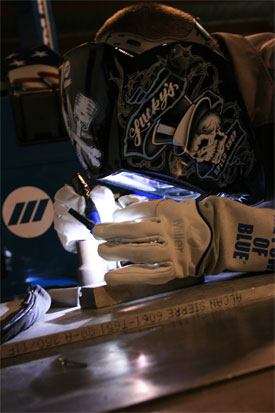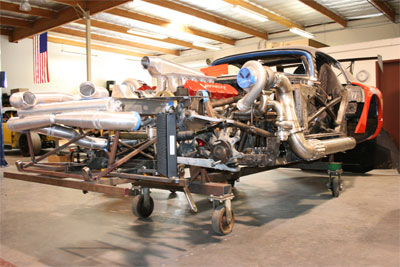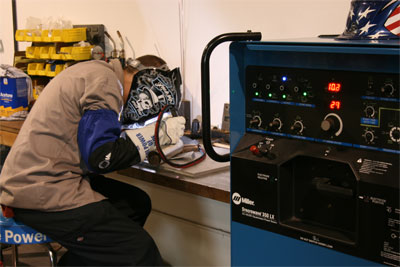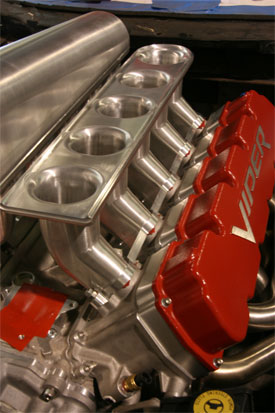Syncrowave® 350 LX TIG Welder Allows Twins Turbo to Fabricate Custom Aluminum, Steel Components for Race Cars
Print Article
Twins Turbo of Long Beach, California relies on Miller's Syncrowave® 350 LX TIG welder to fabricate custom aluminum and steel parts in the highly competitive motorsports industry.
Executive Summary
- Easily switches from aluminum to steel, thick to thin.
- Simple, logical interface.
- Balance control allows operator to adjust cleaning and penetration action on the fly.
- Pulsed TIG capabilities used on components where aesthetics are key.
Welding for Horsepower
Twins Turbo of Long Beach, California uses Syncrowave® 350 LX to weld custom components that blow the doors off the competition.
 |
Marc Kozeluh of Twins Turbo welds a waste gate dump for the ’97 Viper’s turbo exhaust system.
|
Marc Kozeluh jokingly relates the work he and his brother, Eric, do for Long Beach, California’s Twins Turbo to an old farming adage: The dumber the farmer, the bigger the potato. While there is nothing “dumb” about what these motorsports fanatics do in their shop, their work often bucks conventional wisdom to achieve alarmingly good results. The Mazda RX7 engineered and maintained by Twins Turbo was 2007’s fastest Time Attack car in the USA. This injection of serious bragging rights and street cred has brought some challenging new work into their garage by way of a ’97 Viper that should set some records of its own.
Years of design experience and countless hours on the racetrack guide Twins Turbo in its daily work but one skill – the ability to expertly weld a variety of alloys – has made much of their success possible. Marc’s passion to build and design custom race car components has made him an excellent welder and an intense student of the art of welding. He has documented his processes over the years and obsessively references his notes when new problems arise. For the last five years he says one machine—the Syncrowave® 350 LX from Miller Electric Mfg. Co. – has helped him weld the many custom designs that add style and horsepower to their work.
Building Power In, Taking Weight Out
A basic thread runs through each of the cars in the Twins Turbo shop: Redesign a vehicle to add strength while reducing its overall weight. The Mazda RX7 that raced in the Time Attack started out as little more than a stock machine, topping out at about 320 horsepower (hp). Twins Turbo stripped the car down to the engine block and chassis, removed dead weight, redesigned elements of the frame and designed new headers, brackets, water pumps and an intake manifold. They lowered the center of gravity, straightened out the suspension geometry and reduced the car’s weight. Using everything from mild steel and aluminum to stainless and chrome-moly, the Kozeluh brothers were able to prep the car to make 500 hp and 400 torque in conservative road race trim.
 |
This view of the ’97 Viper shows the custom intake manifold, intake coolers and turbo exhaust.
|
“You can ask any rotary expert and they’ll tell you that can’t be done,” says Kozeluh with a grin. “I can take the data from the ECU and send it to an expert and he’ll say ‘when did this blow up? When did it break?’ It’s still running.”
Many custom car builders buy stock or pre-made components to build a car. Twins Turbo, on the other hand, takes the time to design, form and build components that achieve their power goals rather than limit a car’s performance based on what is available on the market. Much of their prototyping work has been made possible by their use of the Syncrowave 350 LX from Miller Electric Mfg. Co.
“There’s no way we could do anything we do here without having the ability to weld.” say Kozeluh. “We’ve had this Syncrowave 350 LX now for five years and I’ve had zero problems with it.”
The Syncrowave 350 LX has a rated output of 350 amps at 34 volts (60 percent duty cycle) and is capable of TIG, Stick and Pulsed TIG welding processes. The machine provides Kozeluh with more than enough power as most of his welds never exceed 225 amps. The variety of welding and alloys on their cars also requires him to switch regularly between alloys and settings, something he can quickly do with this machine.
“I can easily switch on the fly,” claims Kozeluh. “The machine is really easy to switch from aluminum to steel or from thick to thin, it’s really easy. I just change the tungsten out, switch the welder over and adjust the amperage to what I’m welding.”
The Syncrowave 350 LX offers a simple, logical interface and a number of features that make switching between processes easy for the operator to do with minimal effort and confusion. The Last Procedure Recall function makes it easy to move between metals and processes with the flip of a switch. Digital welding meters located on the operator interface display both the amperage and voltage levels (actual and preset values) for greater accuracy and repeatability.
 |
The Syncrowave 350 LX’s balance control allows Kozeluh to adjust cleaning and penetration as he goes. Manipulating the current allows him to manipulate the arc from completely balanced to improved penetration or improved cleaning action.
|
Squarewave Technology, Balance Control Make Tough Welds Easier
Many of the components Twins Turbo designs are formed from aluminum. Kozeluh spends much of his time using the Syncrowave 350 LX’s TIG welding capabilities to create components like a custom-built 6061 aluminum intake manifold for the ’97 Viper. That one component took more than three weeks of preparation, welding and grinding to complete and Kozeluh took advantage of the machine’s advanced TIG capabilities to successfully weld it.
“The ability to control the dig and to adjust the cleaning action and penetration has helped us overcome a lot of challenges,” he says.
Kozeluh refers to the Syncrowave 350 LX’s balance control which allows the operator to adjust cleaning and penetration as he goes. Manipulating the current allows him to manipulate the arc from completely balanced to improved penetration (shorter electrode positive wave, longer electrode negative wave) or improved cleaning (longer electrode positive wave, shorter electrode negative wave). Miller’s patented squarewave technology also makes TIG welding on aluminum easier by providing greater arc stabilization, preventing arc rectification and eliminating tungsten erosion.
Kozeluh goes on to describe the .065 wall aluminum used on the Viper’s custom built intercoolers. While being formed the tubing is bent and the outer wall of the bend is stretched much thinner (.040-in.) than the .065-in. inner wall. Marc takes advantages of the Syncrowave 350 LX’s adjustability to weld continuously from thicker to thinner materials without a problem.
 |
The engine and intake manifold of the ’97 Viper. The plenum here is not yet welded but positioned to check fit-up.
|
Squarewave Technology, Balance Control Make Tough Welds Easier
Many of the components Twins Turbo designs are formed from aluminum. Kozeluh spends much of his time using the Syncrowave 350 LX’s TIG welding capabilities to create components like a custom-built 6061 aluminum intake manifold for the ’97 Viper. That one component took more than three weeks of preparation, welding and grinding to complete and Kozeluh took advantage of the machine’s advanced TIG capabilities to successfully weld it.
“The ability to control the dig and to adjust the cleaning action and penetration has helped us overcome a lot of challenges,” he says.
Kozeluh refers to the Syncrowave 350 LX’s balance control which allows the operator to adjust cleaning and penetration as he goes. Manipulating the current allows him to manipulate the arc from completely balanced to improved penetration (shorter electrode positive wave, longer electrode negative wave) or improved cleaning (longer electrode positive wave, shorter electrode negative wave). Miller’s patented squarewave technology also makes TIG welding on aluminum easier by providing greater arc stabilization, preventing arc rectification and eliminating tungsten erosion.
Kozeluh goes on to describe the .065 wall aluminum used on the Viper’s custom built intercoolers. While being formed the tubing is bent and the outer wall of the bend is stretched much thinner (.040-in.) than the .065-in. inner wall. Marc takes advantages of the Syncrowave 350 LX’s adjustability to weld continuously from thicker to thinner materials without a problem.